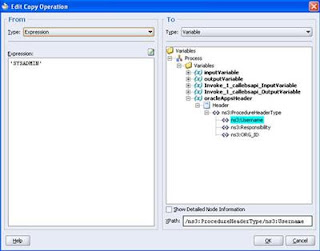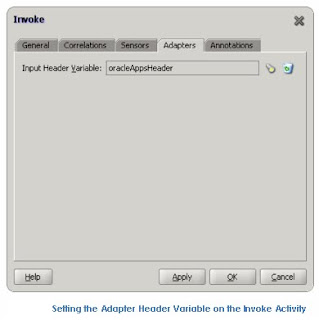1. Do we need to install Oracle Fusion middleware separately and then integrate with R12 or is it included in R12 ?? Also do we need a separate license for that ?
Incase you are planning an upgrade of your existing Ebusiness version from 11i to R12 and also want to integrate with Oracle Fusion Middleware(OFMW), please note that you have to separately install OFMW. The integration with Ebusiness is done using EBS Adapters. The separate installation of OFMW contains the SOA Suite components of BPEL Process Manager, ESB server, adapters etc which arent shipped with the scaled down version of R12 techstack (Oracle application server). And Yes OFMW is licensed separately.
2. Do we have any training links for learning more about SOA Integrations with EBS ?
- You can go through this 10 minute presentation(with voice) to get a broader picture of Service Enabling Oracle E-Business Suite with Oracle Fusion Middleware
- Also you can go through the Oracle Fusion Middleware Best Practice Center for E-Business Suite in OTN with lots of technical, hands-on content geared to E-Business Suite Developers and Technologists to show you how to start creating SOA with your E-Business Suite applications today.
In order to support application-level security to authorize use of its APIs,the Oracle E-Business Suite Adapter allows the use of a header variable in the BPEL process. At a minimum, the header variable must contain the application username and responsibility to use to pass application level authorization. Additionally it can contain the organization to use for the username and responsibility, depending on the version of E-Biz and whether E-Biz is configured to use multiple organization units. Since a BPEL process can invoke multiple PL/SQL using this header variable, this is usually declared as a global variable of the header type and assigned the username and responsibility early in the BPEL process.
- When we create a partner link service,JDeveloper creates a WSDL named procedureAdapterHeader.wsdl that defines the message type for the Oracle Applications header, so we only need to create a global variable of this type.
- Then, an assign activity is added to the BPEL process that allows the global header variable to be initialized for use later.
- Then, when the Invoke activity in the BPEL process is added for adding a task in E-Biz, we select the variable storing our E-Biz credentials to use in the API using the “Browse” flashlight icon. That’s it! And now we can access the APIs we select without errors from Oracle.


Also please note that JDeveloper does embed a standard username and responsibility in the partner link WSDL it creates for E-Biz APIs. By default it will embed a username of “sysadmin” and responsibility of “System Administrator” in the

4. What is WF_BPEL_Q and where is it used ? Do we have a procedure or concurrent program to clean up/purge records from table WF_BPEL_QTAB?
WF_BPEL_Q is an advanced queue which comes into picture when we are doing integration with Oracle Apps business events system. Apps is preconfigured with numerous Business Events and each Business Event represents a ready to use Integration or extension point.When a user from Jdeveloper creates/configures an EBS adapter as a partner link and selects the APPS event to be listened , following activities happen in backend:
- WF_BPEL_QTAB queue table created, if it does not exist.
- WF_BPEL_Q queue created, if it does not exist.
- Start WF_BPEL_Q
- WF_BPEL_QAGENT , if it does not exist
- Create and start wf_bpel_qagent listener, which listens on WF_BPEL_Q.
- Event subscription for that particular event in WF_EVENT_SUBSCRIPTIONS table , if it does not exist.Note that for a particular event , only 1 event subscription is created irrespective of number of BPEL processes (you can have more than 1) subscribing to it.
- AQ Subscriber to uniquely identify the BPEL process consuming the event. This subscriber is created in APPS.AQ$_WF_BPEL_QTAB_S table. This subscriber is needed since consuming business event is dequeue operation and each BPEL process consuming the event should identify itself with unique subscriber name. So ,say bpel1 and bpel2 subscribe to event1 ,two subscribers would be created in APPS.AQ$_WF_BPEL_QTAB_S table so that AQ knows it has to provide event message to bpel1 and bpel2.
- When the BPEL process is deployed in the BPEL PM, the listener keeps polling the WF_BPEL_Q with whatever freqeuncy we have defined.
- Once the corresponding event is raised , it is enqueued into the WF_BPEL_Q and the listener(spawned by BPEL PM) which is listening to this event, would dequeue this and starts the BPEL process.
Well there are no purge programs which does purging of messages from this queue table. This being an AQ table,it should work like any other AQ where once the retention time is reached the record will be cleaned up by the background DB processes.For WF_BPEL_Q retention time is 86400 seconds.. ie 1 day; message would be retained for 1 day after successful dequeue of the message by all the registered subscribers.
However if there are discrepancies observed in removal of records there can be 2 reasons:
- Say if subscriber(BPEL Process) A and B are registered to receive message, and only A has dequeued it, the message would sit indefinitely unless B too dequeues it. After both A and B dequeue, message would then be removed.
- Another reason maybe when there are some wrong BPEL processes( subscribers here) registered for the business event and never dequeued it. In that case you can check out the subscribers table for WF_BPEL_Q i.e aq$wf_bpel_qtab_s and remove all the stale subscribers from it. Removing subscribers automatically removes the messages meant for it.
Almost 90% of Oracle Apps customers have some or the other kind of customizations existing in their implementations. They would definitely like to have these custom objects exposed to the IREP UI so that they can be used for integration scenarios.
EBS Adapter does support custom PLSQL APIs created under Apps schema and shows up these in the Application Module Browser screen of Jdev while configuring the adapter. However this support is limited to objects created only under Apps schema and doesnt extend to custom objects under non-Apps schema.
Also starting with Release 12.1.1, we have a standalone IREP parser script being made available to customers (after application of some one-off patch) which lets them expose their custom objects to the IREP UI. This support doesnt exist in IREP of R12 or 11i. To learn more about How to Customize IREP please check the blog http://blogs.oracle.com/integration_repository_customization
hi ,
ReplyDeleteI need to integrate Oracle EBS 12.1.1 with a MS .Net based system, can i use oracle SOA Gateways inbuilt in 12.1.1. Do we need to have seperate licesence for the same ? or can we use r12.1.1 licesence ?
Hi Shirish
ReplyDeleteYou don't need a separate license for using Oracle Integrated SOA Gateway in 12.1.1 as this product feature is shipped out-of-the-box and should be included within the 12.1.1 EBS license itself.
Hi,
ReplyDeleteI am trying to make a connection with E-Business Suite using the Oracle Applications Adapter and the Enterprise Service Bus. I am following all the steps:
Defining a Business process based on the BPEL standard (through Integration tier (BPEL) in jdev)
After setting up the environment I can drag the oracle applications adapterand giving all the required info to connect to DB.
Now , if I am connecting through APPS user then-
In Oracle aplication module browser, I can see all the product families as well as all the maps.
but when I am connecting through any other user (other than APPS), I am getting product families but not getting any map detail after extracting it.
Are there any specific privileges I need to provide to this user to access XMLG maps/DTDs
Also, I can see only APIs, through custom user, neither Tables nor Views.
One more thing I noticed-
when I am connecting through APPS user, it's popping up a message that the Irep file is extracted, but through non APPS user I am not getting that meassage. I am working on R12.
Thanks in advance,
KS
Are you trying to access any custom objects created under the non-apps schema ?
ReplyDeleteXML Gateway maps and DTDs are created under apps schema. If you are trying to access these via non-apps schema you will have to grant specific privileges.
No, I am not trying to access custom objects. I am trying to access standard objects through non-APPS user. I didn't give any grants to APIs to my custom schema, though I can see these APIs in oracle Application module browser, when I am connecting through Non apps user.
ReplyDeleteAny idea, what all privileges I need to provide to my non-apps schema.
Even for tables, though I have created in Custom schema, I can't see it through Custom schema-it's just giving count.
Thanks,
KS
@KS
ReplyDeletetry attending the one-hour webcast from Oracle which shows the Service Oriented Architecture (SOA) capabilities within E-Business Suite R12 focusing on the E-Business Suite Adapter.
For further details check
http://blogs.oracle.com/stevenChan/2011/02/reminder-atg-webcast-soa.html
You can raise your questions here as well.
We have implemented one custom application, that is built on Integration Repository of Integrated SOA Gateway in R1213. This feature will come in R12 by default but not in 11i. For that do we need to install the Fusion middleware(SOA) separately then have the integration repository..?
ReplyDeleteFor 11i, yes you need to have a separate installation of Fusion Middleware in order to develop integrations. You can use the Ebiz adapter from your fusion(bpel) process. Jdeveloper has the irep embedded within the config wizard.
DeleteHi,
ReplyDeleteI want to deploy a Custom BPEL in the ISG. After that I want to invoke it through SOAP-UI tool. At the run time does the custom BPEL run inside the R12.1.3 or it need an additional SOA Suite/BPM Engine? That means is the END-POINT refer inside the ISG or it has to refer to external SOA Server? If it has to be an external server then what is the use of publishing a Custom BPEL in the ISG?
Quick response is appreciated as I have to use this concept for my design and deployment diagram.
--Khaleel